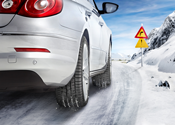2010 Winter Tires Buying Guide

As the temperature in the UK starts to drop discussion naturally turns to winter tires. After last seasons extremely heavy snow fall, people now understand winter tires exist, but aren't quite sure which type of tire or what brand of winter tires is best.
All Season, Winter or Snow Tires?
The first step in selecting a tire for the cold season is understanding what types of tire are on the market, and what they're specifically used for.
The first option is all season tires. All Season tires are designed to work year round and as such, are compromised for both normal road driving and when it snows. While they would work in the UK, they're not very popular as the UK climate has fairly well defined warm and cold seasons, with extremes in temperature which would leave all season tires as pointless as their summer tires.
The next option is snow tires. These are designed with one thing in mind - snow and ice and are largely used in countries with extremely heavy snowfall. Designed with metal studs embedded into the rubber, these tires bite into ice and compacted snow giving excellent grip in extreme weather. Snow tires are overkill for the UK, and you would quickly destroy a set of studded tires if you used them on non-snow covered roads.
The final option is Winter tires. Winter tires are designed for climates that have prolonged periods of cold, and can work with a little, or a lot of snow fall. The key to winter tires is they're designed to work in conditions where the average temperature is below 7c for long periods. While winter tires aren't "snow optimised" like snow tires, they are many many times better than summer tires when the snow falls and offer improved grip in any temperature below 7c.
Which winter tires for my car?
While the British magazines perform annual tire tests for summer performance tires, the German and northern European magazines also release annual winter tire tests every year giving excellent buying advice. After aggregating the magazine tests and reviews on TireReviews we recommend looking into the following tires:
| Ultra High Performance | |
 |
Continental Winter contact TS830P The Continental Winter contact TS830P is the latest UHP winter tire from Continental and placed 1st in the 2009 Sport Auto Winter Tire Test. The tire was prasied for excellent braking performance in snow, rain and the dry and having consistently high level of grip in the wet and snow. |
 |
Pirelli SottoZero Serie II The Pirelli SottoZero Serie II is another ultra high performance winter tire. It has both excellent reviews on the site, and placed second in the 2009 Sport Auto Winter Tire Test with the remarks "Very balanced and good grip levels. High traction and braking performance in snow and rain". |
 |
Nokian WRG2 The Nokian WRG2 is a TireReviews favourite, with near universal praise. While classified as a winter tire it has excellent dry weather properties making it particularly suited the UK's climate. |
| High Performance / touring | |
 |
Dunlop Winter Sport 3D Placing 3rd in both the the 2009 Sport Auto and AMS winter tire tests the Dunlop Winter Sport 3D is an excellent choice for the UK's roads. |
 |
Vredestein Snowtrac 3 The Vredestein Snowtrac 3 is an excellent tire for small to medium sized cars and gets great reviews here at TireReviews. |
 |
Bridgestone Blizzak LM30 The Bridgestone Blizzak LM30 was launched in 2009 and targeted towards compacts, mid-sized cars and family saloons up to T and H speed ratings. It promises to be one of the leading tires in this years magazine tests so is certainly worth considering. |
If anyone has any other suggestions please comment below or drop us an email.
Further Reading:
- 7 reasons to consider winter tires- Guide to tire seasons







